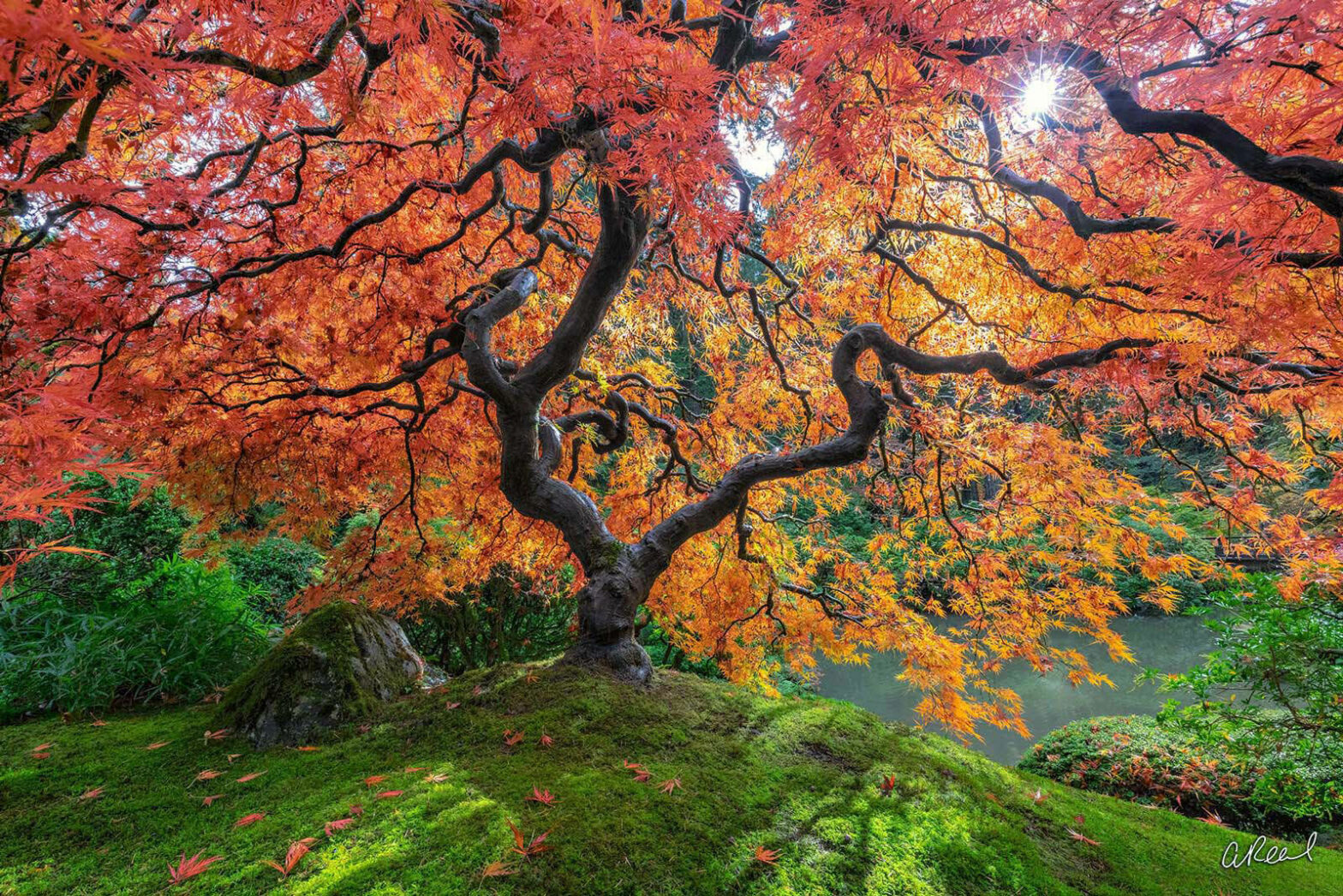[ad_1]
The Art of Japanese Gardens
Humans have always struggled to find ways of keeping in touch with nature as farming, industry, and modern cities have pushed away and fenced off the natural world around us.
Solutions to this problem have ranged from National Parks to municipal landscaping, but none have rivaled the harmony and perfect synthesis of the traditional Japanese garden. For a millennium and a half, these sculpted enclaves of nature have provided inspiration and relaxation, and today they are widely viewed by photographers, artists, architects, and more as one of the most beautiful and important expressions of art and design.
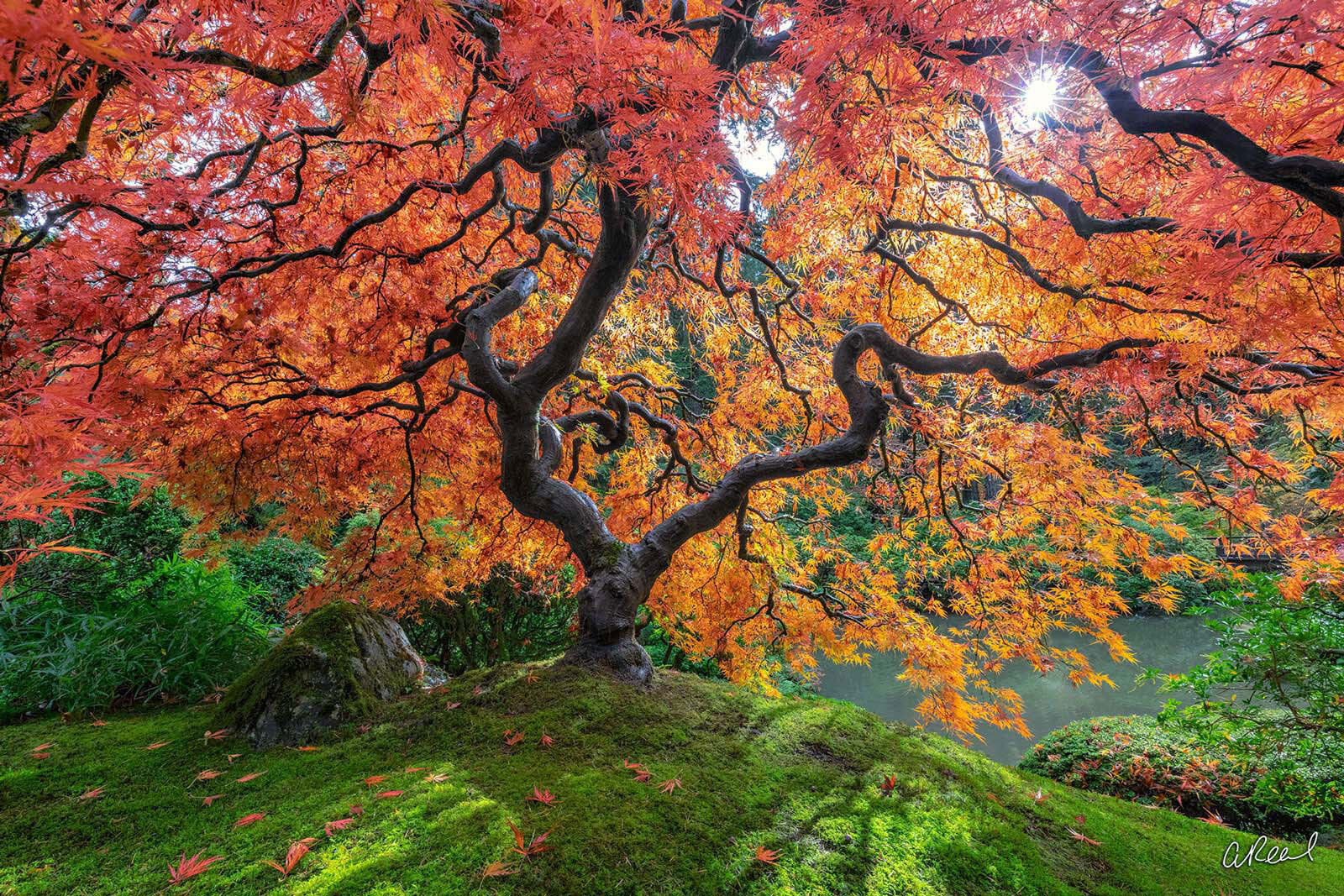
A legendary Japanese maple at the height of its autumn spendor sits on a hillside inside the Japanese garden in Portland, Oregon. Fine Art Limited Edition of 100.
The History of Japanese Gardens
Japanese gardens were first imported from China in the 6th century Asuka period, when Chinese gardening methods and design elements were fused with aspects of the local landscape. The high mountains, great forests, running streams, and deep valleys were all reproduced in miniature around the palaces of nobles, the only ones who could afford such stylistic expression at the time.
Chinese influence increased during the Heian Period (794-1185), when much of the Tang Dynasty governmental apparatus, writing system, and culture were imported to the Japanese islands. Zen Buddhism began to flourish during this period, and more complex ideas about organization, flow, and aesthetic were combined with philosophical doctrines to produce the first set of stylistic principles for garden design.
These ideas were further developed and cemented during the Kamakura Period (1192-1333), rendering these gardens more recognizable and popular. By the time of the Muromachi Period (1338-1573), they were seeing wider adoption by the public in shared and private spaces. This resulted in a profusion of new styles and philosophies, and by the Edo Period (1603-1867), garden design had become a nationwide artform, engaged in by every level of society.
Since the 1800s, many Japanese households have transformed their traditional interior courtyards into smaller gardens. Because of the spatial constraints, miniaturization is often taken to the extreme, and looking out from the rooms of the house, one has the sense of gazing out over a vast wild landscape. This importation into the home has also allowed each individual or family to design their gardens according to their own aesthetic sensibilities. Today, new creative ideas and elements are emerging all the time alongside a continued respect for and preservation of the antique gardens still standing.
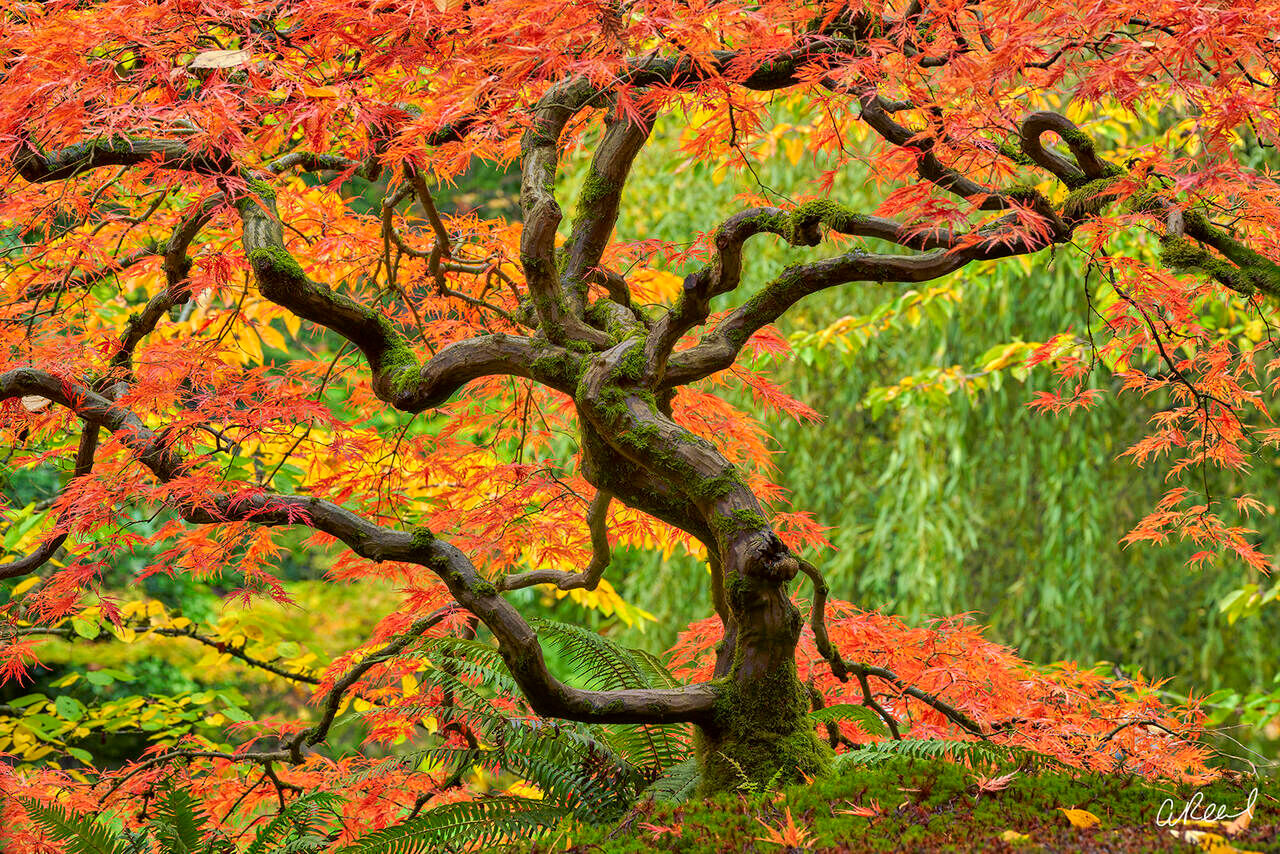
A small twisted Japanese maple tree shows off its autumn color inside the Japanese garden in Portland, Oregon. Fine Art Limited Edition of 50.
Beauty By Design | Essential Elements
The many different styles of Japanese garden each have their own sets of elements and features, but there is much overlap, and some parts which are shared by all.
Water
Water is a core aspect of Japanese gardens. Water can either be represented literally, by small streams, miniature waterfalls, small ponds, or placid lakes. Dry riverbeds are also relatively common, invoking the essence of a flowing river or paying homage to the islands’ dry season. In Zen rock gardens, sand and gravel represent water while not impinging on the spatial balance. Japanese gardens always have water, either a pond or stream, or, in the dry rock garden, represented by white sand. In Buddhist symbolism, water and stone are the yin and yang, two opposites that complement and complete each other. A traditional garden will usually have an irregular-shaped pond or, in larger gardens, two or more ponds connected by a channel or stream, and a cascade, a miniature version of Japan’s famous mountain waterfalls.
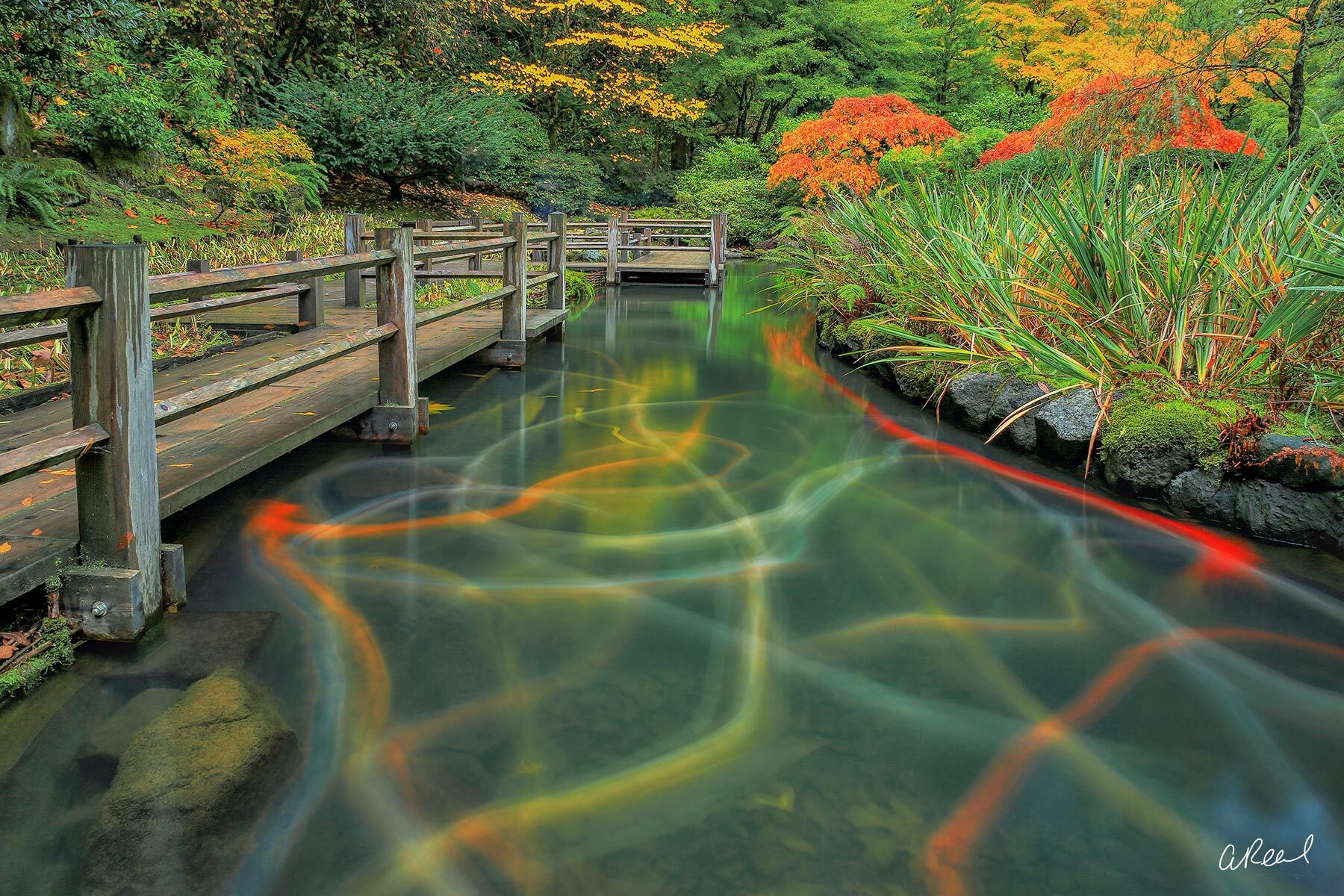
Trees/Shrubs
One of the most stunning aspects of Japanese gardens is their botanical variety. Twisted and moss covered trees are one of my personal favorite photographic subjects. Most gardens are populated by carefully manicured evergreens, their twisting forms calling to mind windswept coastlines or high mountain passes. Cherry trees spread their rosy blossoms over rolling meadows bounded by expertly carved shrubbery. Japanese maple trees have become synonymous with the natural harmony of these gardens, and their star-shaped leaves exchange their vibrant colors with the passing of each Autumn before falling silently to rest on the soil below. Emerald mosses are encouraged to mottle the grey stones of walkways and paths.
Rocks & Sand
Rock, sand and gravel are an essential feature of the Japanese garden. A vertical rock may represent Mount Horai, the legendary home of the Eight Immortals, or Mount Sumeru of Buddhist teaching, or a carp jumping from the water. A flat rock might represent the earth. Sand or gravel can represent a beach, or a flowing river. Rocks and water also symbolize yin and yang (in and yō in Japanese) in Buddhist philosophy; the hard rock and soft water complement each other, and water, though soft, can wear away rock.
In ancient Japan, sand (suna) and gravel (jari) were used around Shinto shrines and Buddhist temples. Later it was used in the Japanese rock garden or Zen Buddhist gardens to represent water or clouds. White sand represented purity, but sand could also be gray, brown or bluish-black.
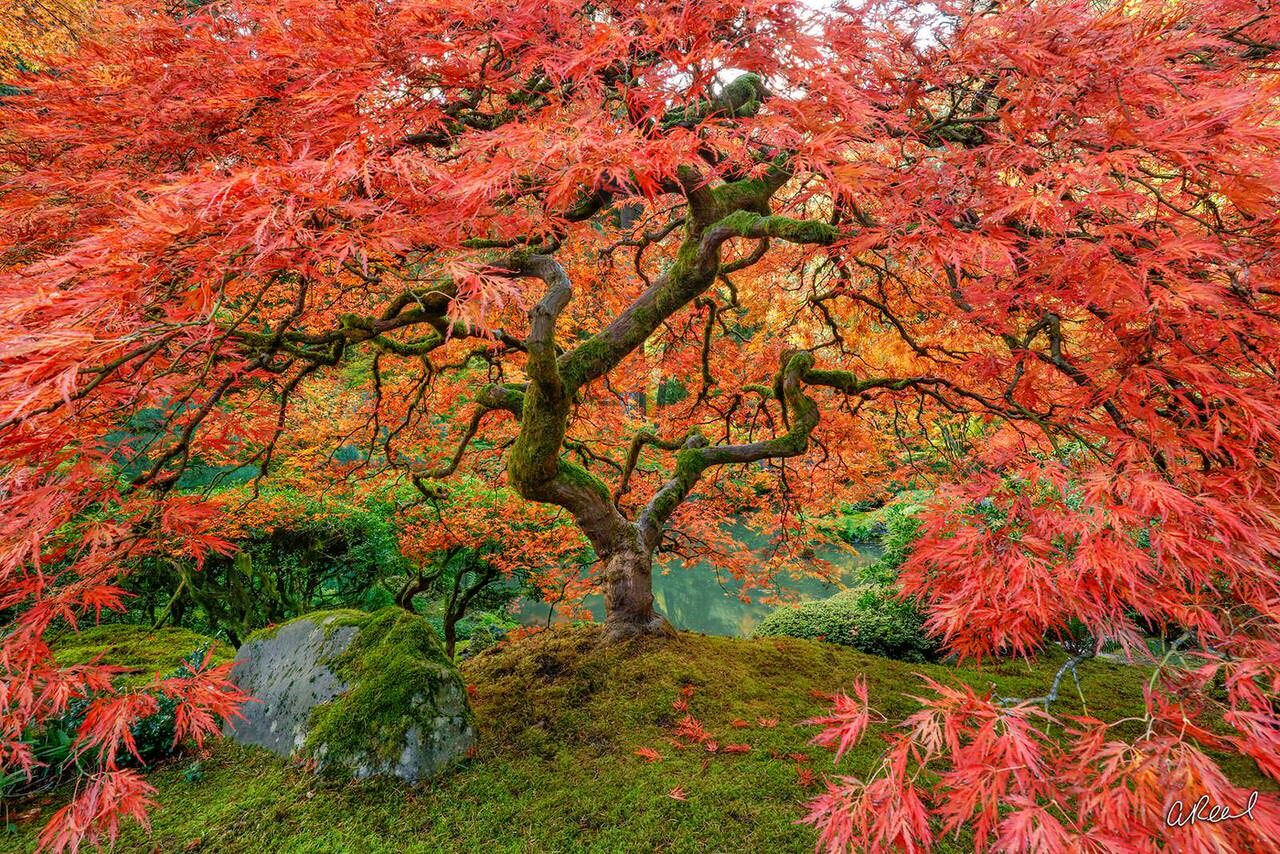
The Portland Japanese garden boasts multiple maple trees, but none more famous than this lace leaf maple photographed at the height of autumn. Fine Art Limited Edition of 200.
Islands
To replicate the foggy mountainscape of Japan’s high places, artificial islands are constructed in many gardens. Their tops offer stunning vistas of the miniature landscape below and their bases are often bordered by lakes and ponds, representing the ocean. These features, along with the trees, create a much more interesting and diverse topography, with many different levels and angles serving to alternatively hide and reveal various aspects of the space.
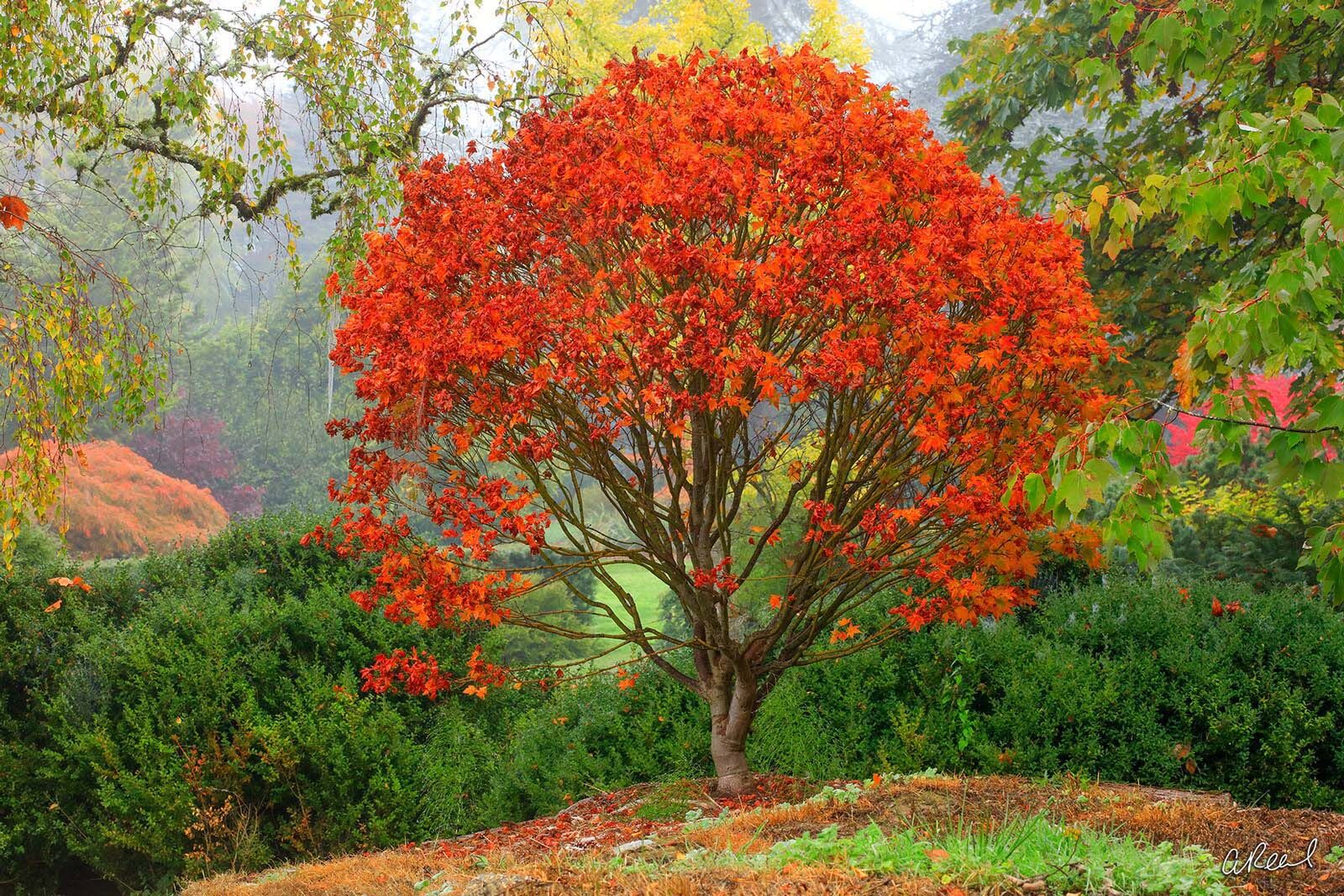
Elevate your home with Aaron Reed’s limited edition photography print, The Burning Bush, from his Amazing Tree Photography collection. Order yours today! Fine Art Limited Edition of 50.
Statues
Beneath the shady boughs and in many a hidden glen, visitors to Japanese gardens will find collections of statuary. These sculptures may depict monks, philosophers, ordinary folk, or even the Buddha himself. Like the many stones in these gardens, they too are encouraged to affect a mosaic of colored lichens and moss.
Bridges and Walkways
Not only the appearance of Japanese gardens is important, but also their presentation. Paths and promenades wind through the landscape, revealing new scenes and vistas with every turn. Allowing visitors to experience each little spot of beauty one at a time creates a much more immersive and interesting experience than laying everything out all at once. To cross the many ponds and streams, various ornamented bridges are included. The eye-catching moon bridges can be difficult to cross at times because of their profound arc, but add to the mystic ambience of the gardens.
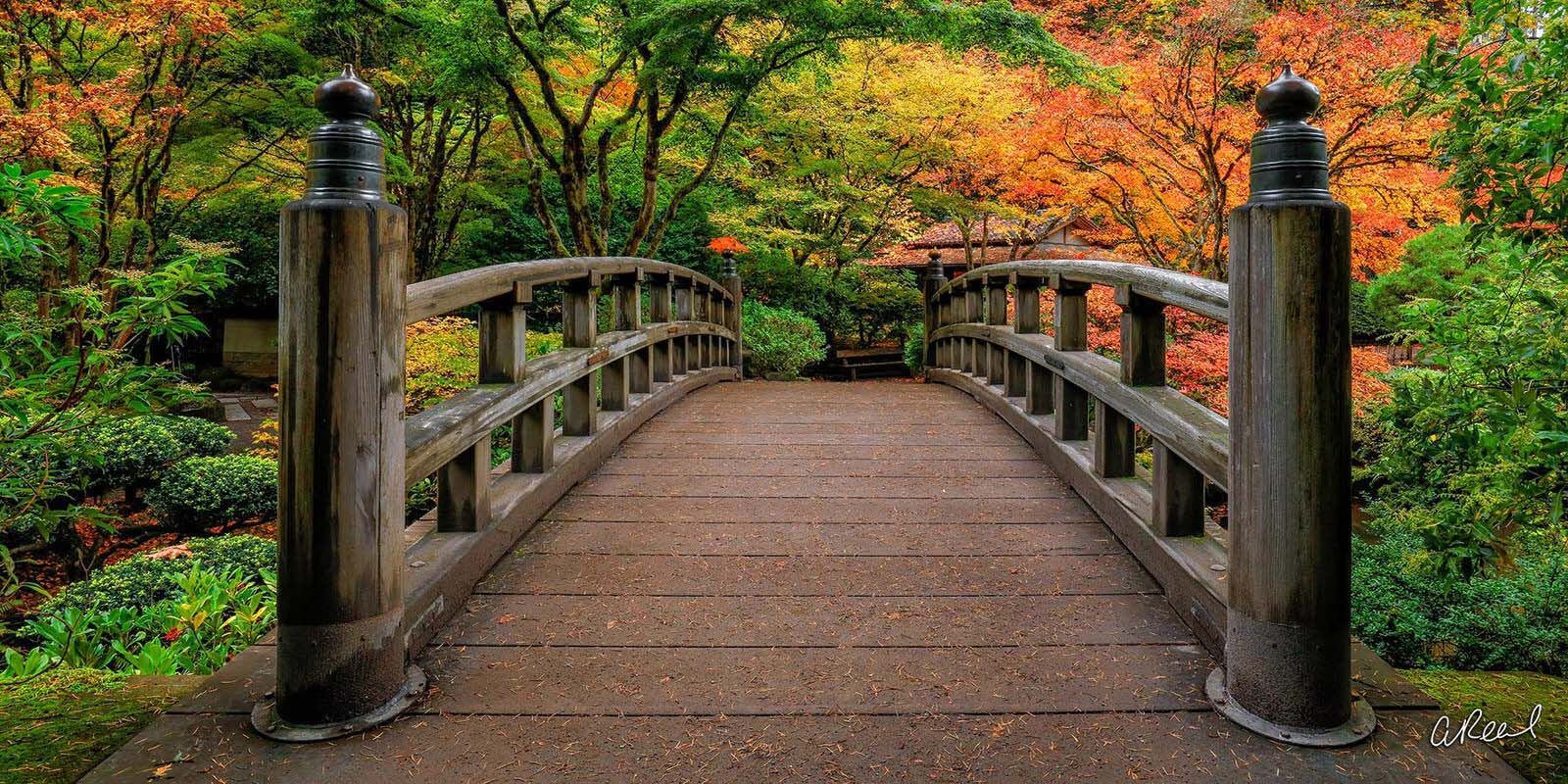
Transform your space with Aaron Reed’s luxury fine art photography print, Silent Lucidity, from his Panoramic Wall Art collection. Order yours today! Fine Art Limited Edition of 100.
Shrines
Some gardens, especially those constructed in the Zen tradition, may feature small shrines and temples to various deities and religious figures. Not all of these are accessible to the visiting public, but their towering pagodas or secluded refuges are a nice human touch which blend with the nature around them.
Lanterns
Another kind of sculpture which deserves its own section are the Japanese stone lanterns or tōrō. These can be hidden away among the shady trees and shrubbery or gathered in rows or collections along the garden paths. Traditionally, lanterns are composed of five parts representing the five elements of nature—earth, water, fire, air, and spirit. Much improvisation and creative innovation has taken place in lantern design, and not all elements may be present, but most still retain their carved base, taloned cap, and void-like central chamber.
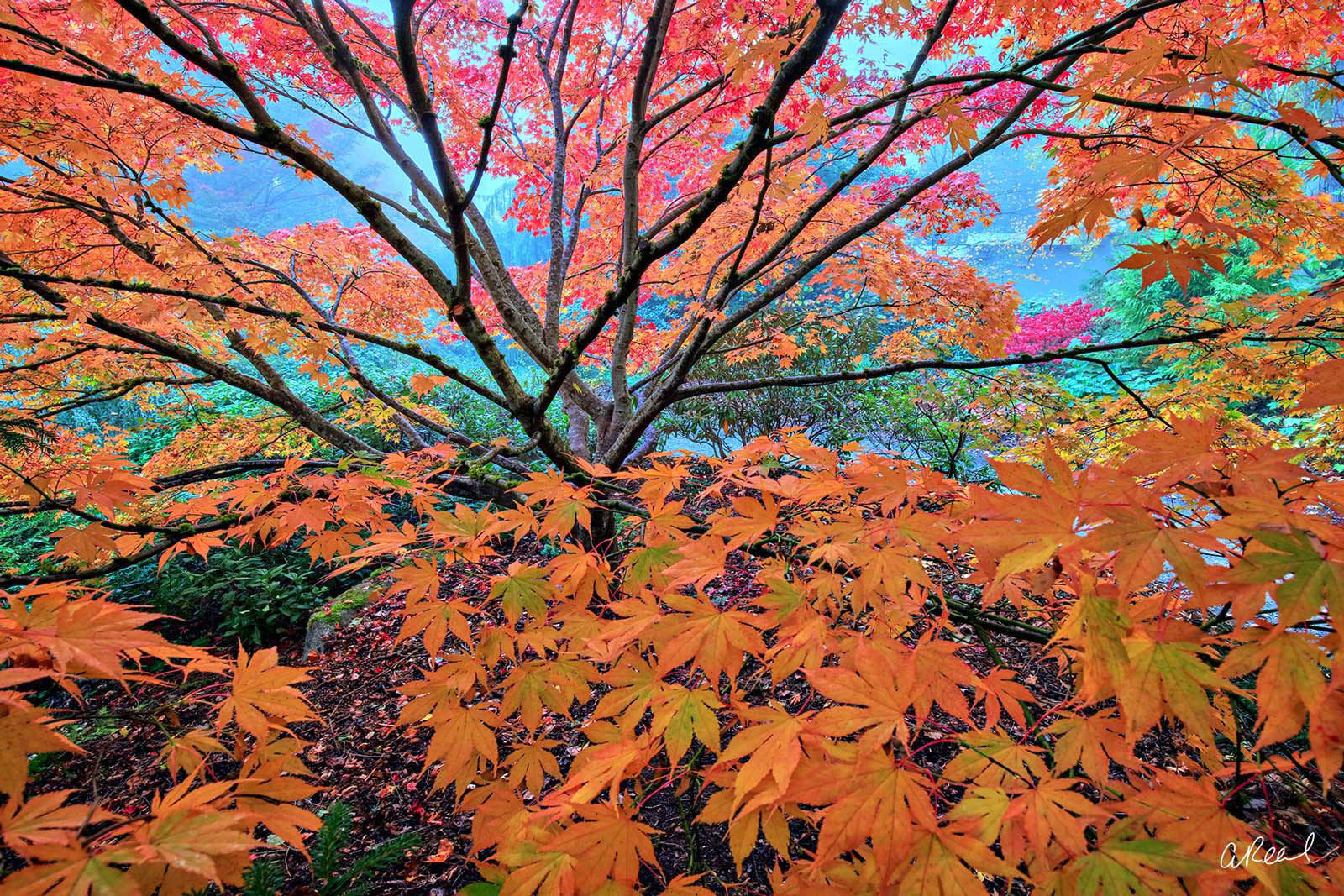
A beautiful autumn morning blanketed by fog inside the Kubota garden in Seattle, Washington. Fine Art Limited Edition of 50.
Fish
The use of fish, particularly nishiki-goi (colored carp), medaka or goldfish as a decorative element in gardens was borrowed from the Chinese garden. Goldfish were developed in China more than a thousand years ago by selectively breeding Prussian carp for color mutations. By the Song dynasty (960–1279), yellow, orange, white and red-and-white colorations had been developed. Goldfish were introduced to Japan in the 16th century. Koi were developed from common carp (Cyprinus carpio) in Japan in the 1820s. Koi are domesticated common carp that are selected or culled for color; they are not a different species, and will revert to the original coloration within a few generations if allowed to breed freely. In addition to fish, turtles are kept in some gardens. Natural environments in the gardens offer habitats that attract wild animals; frogs and birds are notable as they contribute with a pleasant soundscape.
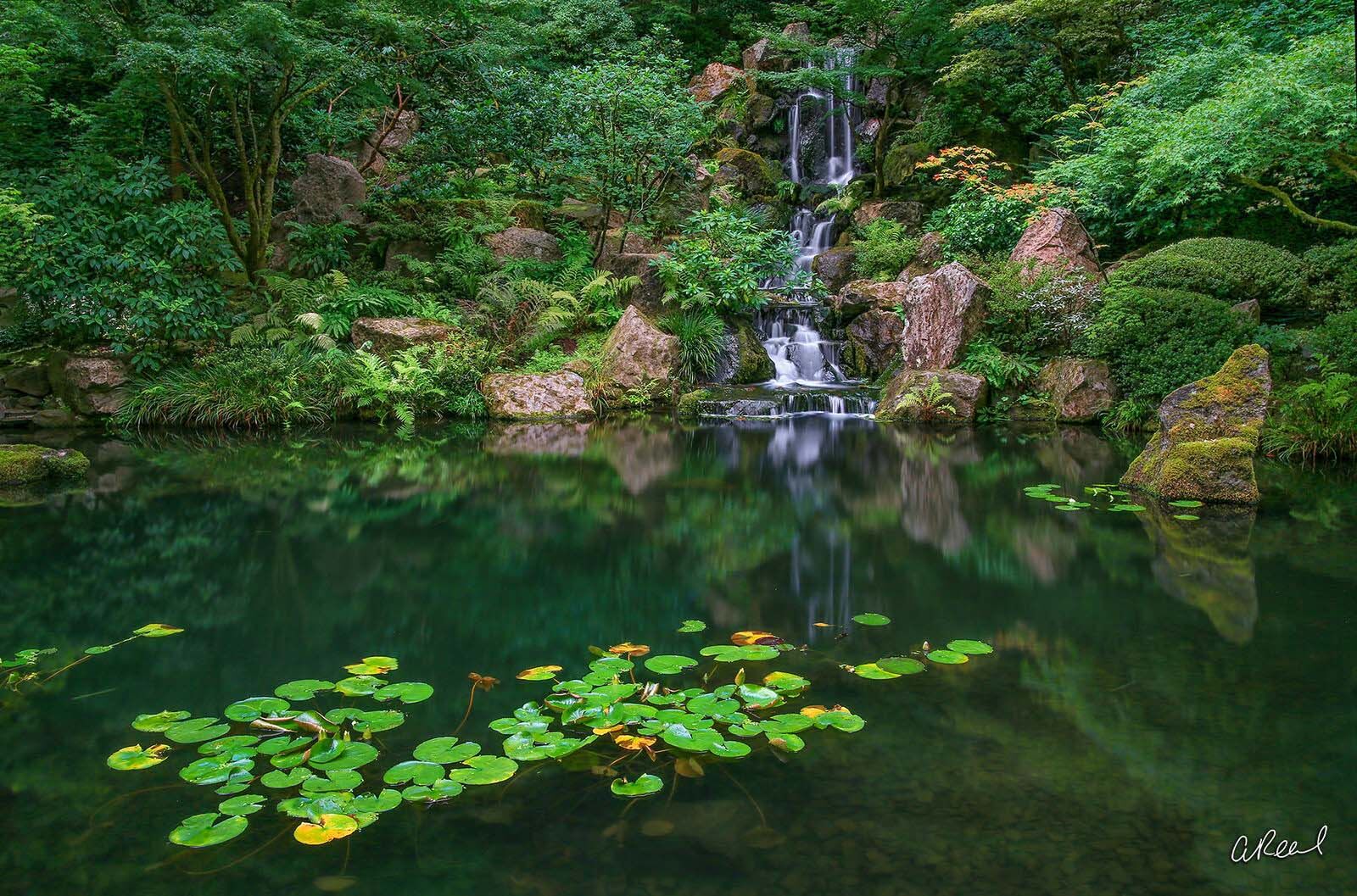
Adorn your walls with Aaron Reed’s limited edition photography print, Feeling Green, from his Oceans & Rivers Luxury Art collection. Order yours today! Fine Art Limited Edition of 50.
The Art and Experience of the Japanese Garden
Together, these and many other design elements have been mixed and matched to derive a multitude of unique styles and aesthetics. Regardless of how they are arranged, though, a deep harmony is always achieved which has fascinated and inspired artists and the public for centuries.
Gardens have figured heavily in Japanese art since their creation. Paper prints, screens, and household items from many eras display nobles strolling alongside lakes beneath maples and cherry trees. Other works focus on the gardens themselves, reproducing quiet scenes from the interior courtyards and temple grounds that have always dotted cities Kyoto and Tokyo. Even today, gardens are often seen in manga and animated shows and movies, given meticulous detail to further publicize the beauty and history of their design.
Photographers have been especially taken with the artistic precision and attention to composition and view in these spaces. Photography is one of the best ways to capture the numerous unique perspectives and minute details of these gardens, and many professional photographers visit them throughout the year to document and capture the seasonal changes and variations in light and atmosphere. The fine artworks produced by professional photographers have also helped to drive greater appreciation for these sacred spaces across the globe.
Anyone who has visited a Japanese garden will be familiar with the sense of calm and peaceful tranquility which pervades them. Many come to see the wonders of their natural design, others to unwind, relax, and reflect. Throughout the world they are known as pinnacles of aesthetic excellence, and though much has changed since their inception, they still speak to the deeper need we all have to join our daily lives to the natural world.

Transform your space with Aaron Reed’s limited edition photography print, Zenetics, from his Abstract Nature Photography collection. Order yours today! Fine Art Limited Edition of 50.
The Portland Japanese Garden
As a Portland native, the Portland Japanese Garden will always be a special place to me and one that I visit almost every year to photograph during the autumn season when the garden springs to life with color.
The Portland Japanese Garden sits nestled in the hills of Portland, Oregon’s iconic Washington Park, overlooking the city and providing a tranquil, urban oasis for locals and travelers alike. Designed in 1963, it encompasses 12 acres with eight separate garden styles, and includes an authentic Japanese Tea House, meandering streams, intimate walkways, and a spectacular view of Mt. Hood. This is a place to discard worldly thoughts and concerns and see oneself as a small but integral part of the universe.
Born out of a hope that the experience of peace can contribute to a long lasting peace. Born out of a belief in the power of cultural exchange. Born out of a belief in the excellence of craft, evidence in the Garden itself and the activities that come from it. Born out of a realization that all of these things are made more real and possible if we honor our connection to nature.
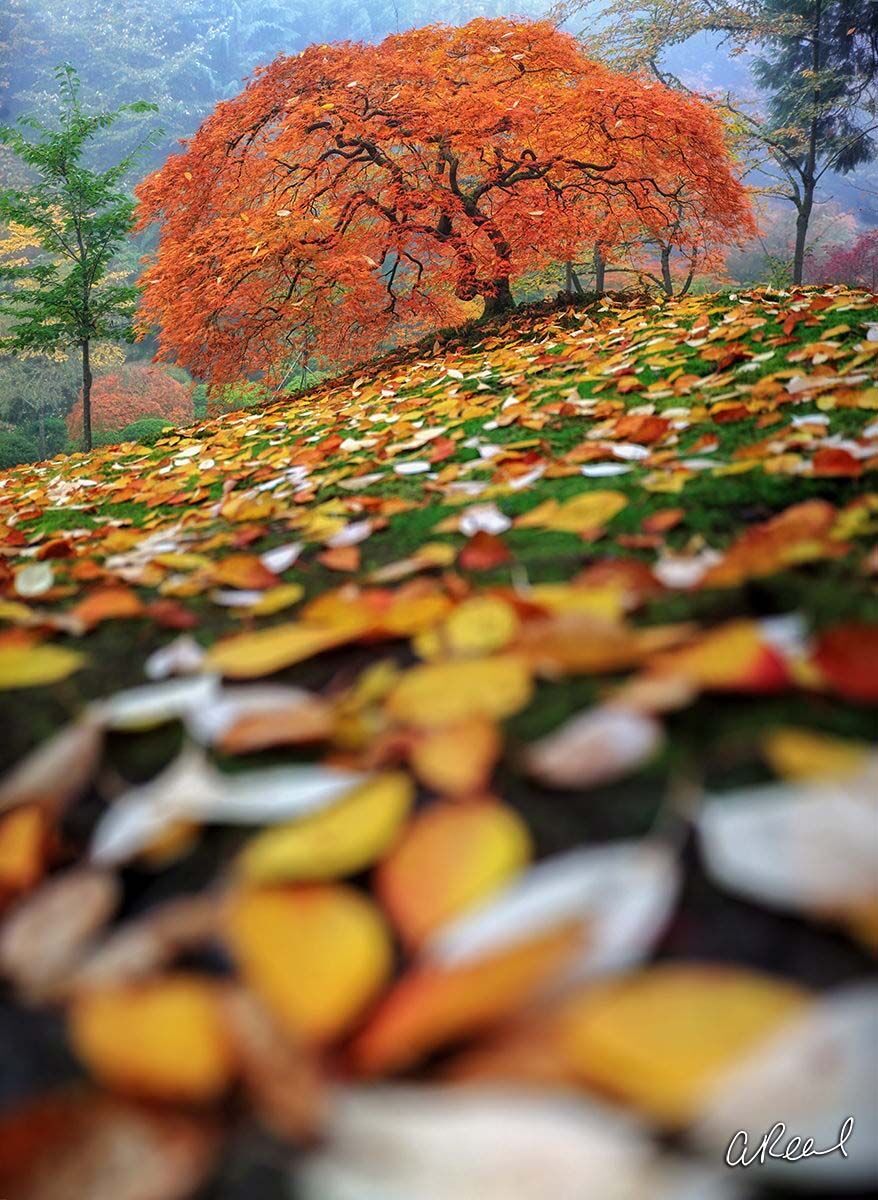
Transform your space with Aaron Reed’s limited edition photography print, Colorfall, from his Vertical Luxury Photography collection. Order yours today! Fine Art Limited Edition of 100.
Portland Japanese Garden Art
The Portland Japanese Garden is a natural vehicle through which to explore Japanese art and design. Art exhibitions explore ideas and aesthetics integral to the fabric of life in Japan. Introducing a wide array of artists and art forms, these exhibitions will reflect on ways we experience peace through connections to art, nature, and one another.
Of all the work I have produced over the years, images created inside the Portland Japanese Garden has been some of my most successful. The simplicity, serenity and peace found inside the garden can be brought inside your home through beautiful artwork created here. To see more and take a virtual stroll through the garden from your chair, please browse the rest of my Japanese Gardens Art Collection and find a piece to bring home to your collection today!
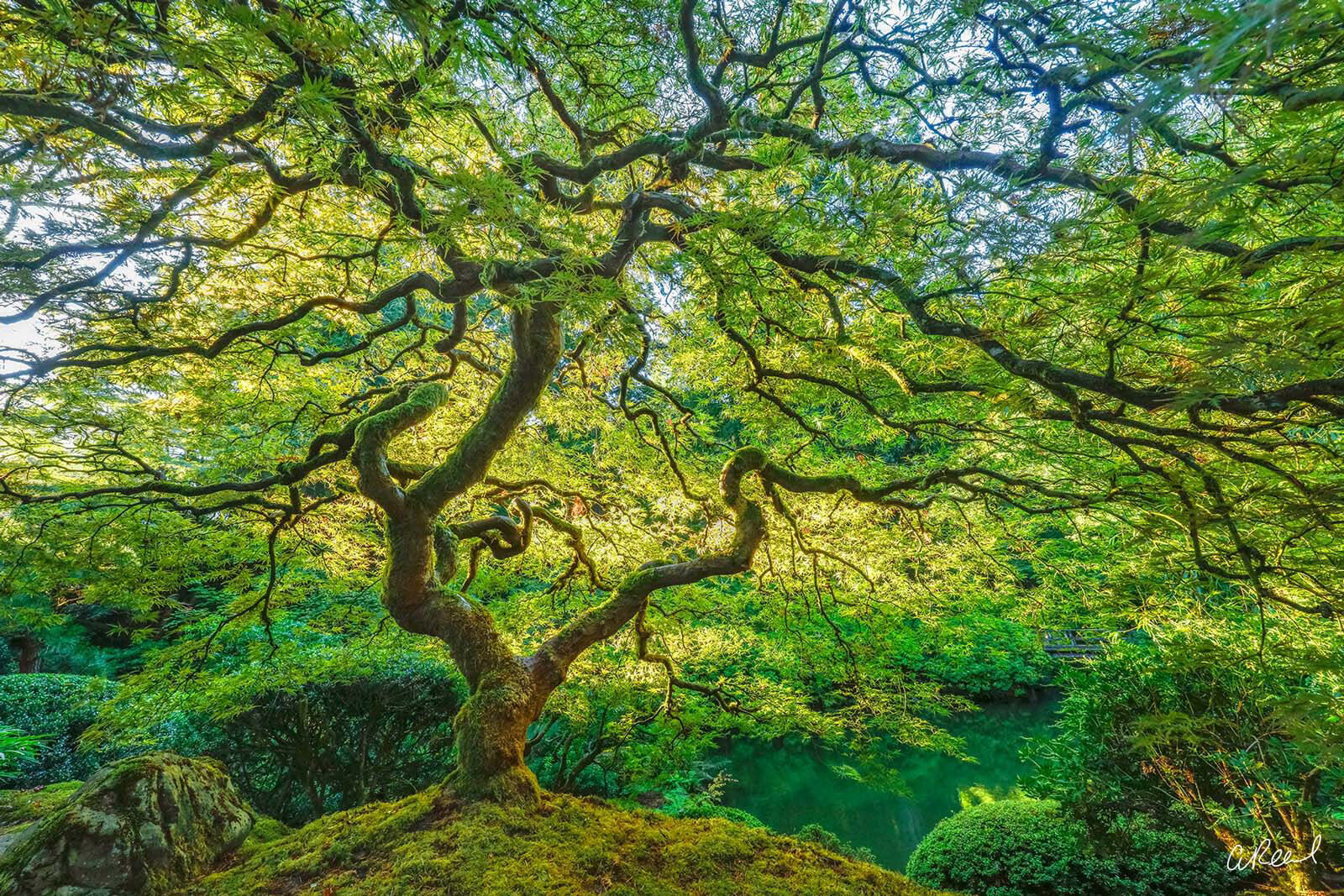
While fall is the season of choice to photograph this popular Japanese Maple tree, the end of summer provides fresh green growth and a distinctly difference yet equally beautiful image inside the Portland Japanese Garden in Oregon State. Fine Art Limited Edition of 100.
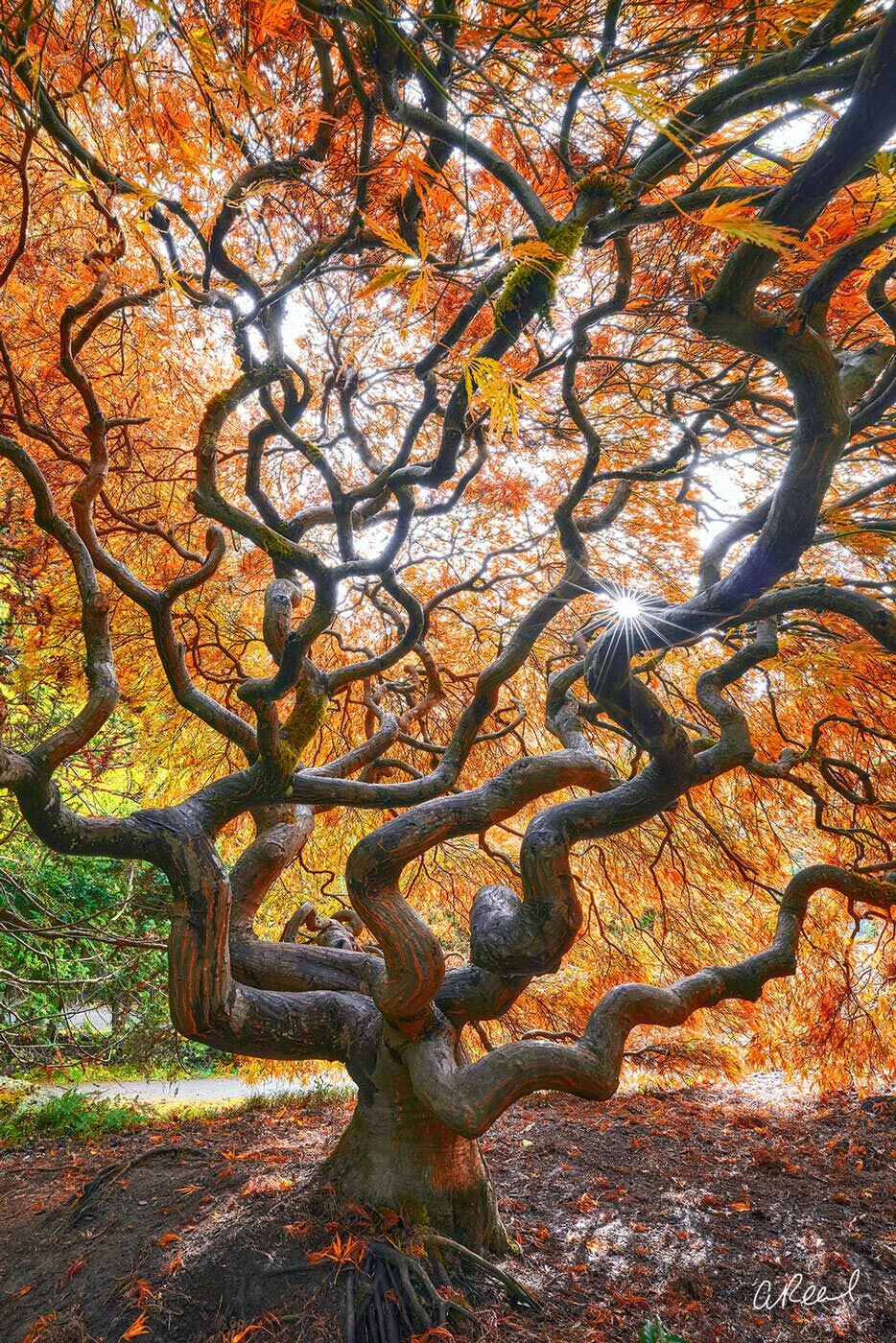
Elevate your home with Aaron Reed’s limited edition photography print, The Shining, from his Newest Work Photography collection. Order yours today! Fine Art Limited Edition of 50.
[ad_2]
